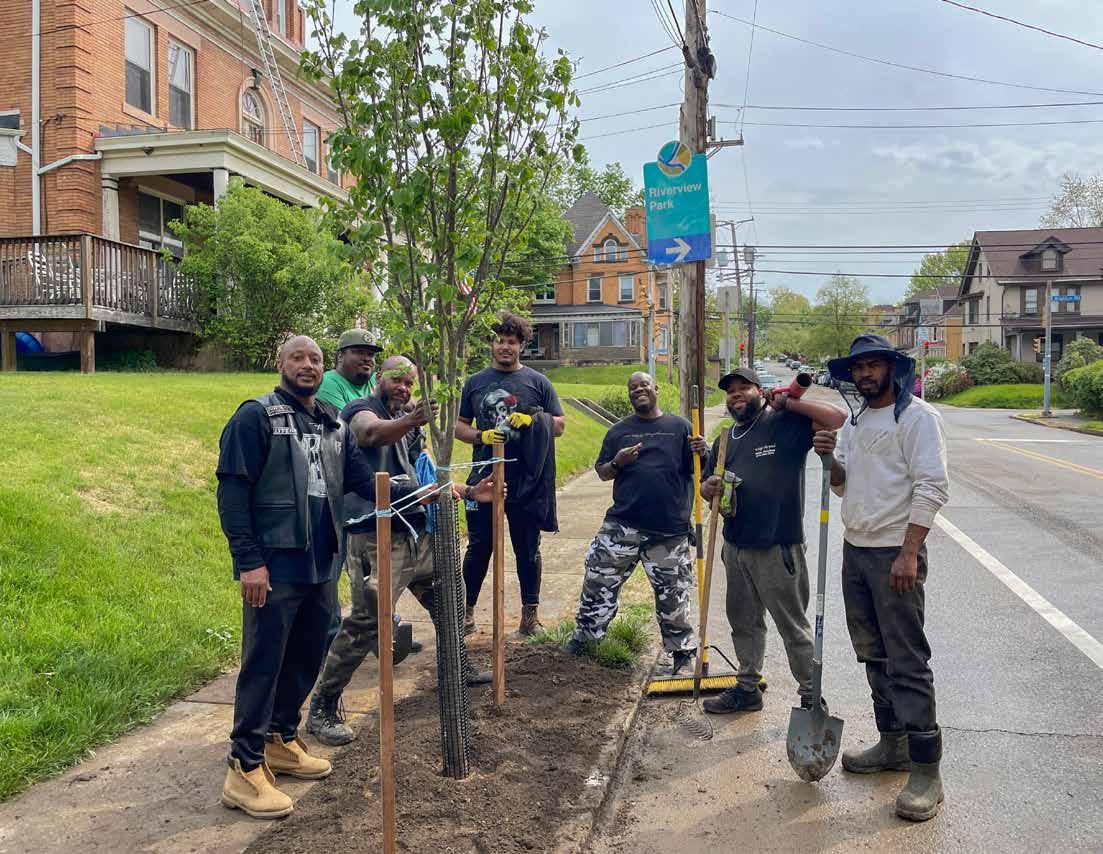

2024

Message from the President
I am pleased to share the Western Pennsylvania Conservancy’s 2024 annual report with you, to highlight the important work you supported. It was a year of strong outcomes at the Conservancy in protecting land, restoring rivers and streams, studying and protecting important habitats, adding trees and landscape to our cities and towns, and stewarding and sharing Fallingwater. Every year, I am inspired by what can be accomplished thanks to your impressive generosity.
In 2024, we achieved significant milestones in land protection, safeguarding more than 22,000 acres of open space. We protected an important landscape in the northern part of our region with a conservation easement of over 19,000 acres, added significant holdings to state forests in the Laurel Highlands,
and added a new nature preserve in the French Creek watershed, an important creek system that feeds into the Allegheny River.
Our watershed team continued its efforts to address the effects of agricultural impacts, abandoned mine drainage, and sediment from dirt and gravel roads on our region’s watersheds, restoring more than five miles of streams in 2024. We also removed four culverts to reconnect more than two miles of stream, and planted trees in large numbers along the banks of our region’s rivers and streams.
Our community greening initiatives, with assistance from many volunteers, provided new street trees and beautiful gardens in our communities, and a combination of more than 1,000 planters and hanging baskets in downtown Pittsburgh.
Our land stewardship team cared for 45 preserves totaling more than 15,300 acres, as well as
The Western Pennsylvania Conservancy protects and restores exceptional places to provide our region with clean waters and healthy forests, wildlife and natural areas for the benefit of present and future generations. To date, the Conservancy has permanently protected more than 290,000 acres of natural lands. The Conservancy also creates green spaces and gardens, contributing to the vitality of our cities and towns, and preserves Fallingwater, a symbol of people living in harmony with nature.
many benefits of membership! For information on WPC and membership 412-288-2777 | 1-866-564-6972 info@paconserve.org | WaterLandLife.org | Fallingwater.org
monitored over 61,000 acres of properties protected by conservation easements. Our natural heritage program assessed rare species and their habitats while contributing research to update the State Wildlife Action Plan.
At Fallingwater, we provided educational programs and learning experiences through tours and with Fallingwater Institute programming, while advancing a large-scale preservation initiative to address Fallingwater’s major building systems.
Thank you for your dedication and support in advancing these outcomes across the region. We couldn’t do this work, which makes such a difference across our region, without your support.

Thomas D. Saunders PRESIDENT AND CEO
BOARD OF DIRECTORS
OFFICERS
Debra H. Dermody Chair
Geoffrey P. Dunn Vice Chair
Thomas Kavanaugh Treasurer
Bala Kumar Secretary
Alfred Barbour
David Barensfeld
Franklin Blackstone, Jr.*
Barbara H. Bott
E. Michael Boyle
Cynthia Carrow
Marie Cosgrove-Davies
Beverlynn Elliott
Donna J. Fisher
Susan Fitzsimmons
Paula A. Foradora
Dan B. Frankel
Dennis Fredericks
Felix G. Fukui
Caryle R. Glosser
Carolyn Hendricks
Thomas F. Hoffman
Gregory M. Hyziewicz
Sanjeeb Manandhar
Justin McCann
PRESIDENT AND CEO
Thomas D. Saunders
Robert T. McDowell
Daniel S. Nydick
Stephen G. Robinson
Samuel H. Smith
Alexander C. Speyer III
K. William Stout
Megan Turnbull
Joshua C. Whetzel III
Gina Winstead
*Director Emeritus
PEOPLE
MAKE OUR WORK POSSIBLE
4,825 community garden volunteers
761 community forestry volunteers
149 land stewardship volunteers
195 watershed volunteers
143,023 visitors from 119 different countries to Fallingwater
2,933 views of “Seeing The Unseen: Aquatic Invaders & What’s at Stake” on WPC’s YouTube channel
Unlimited number of people who can explore one of the 45 Conservancy-owned preserves
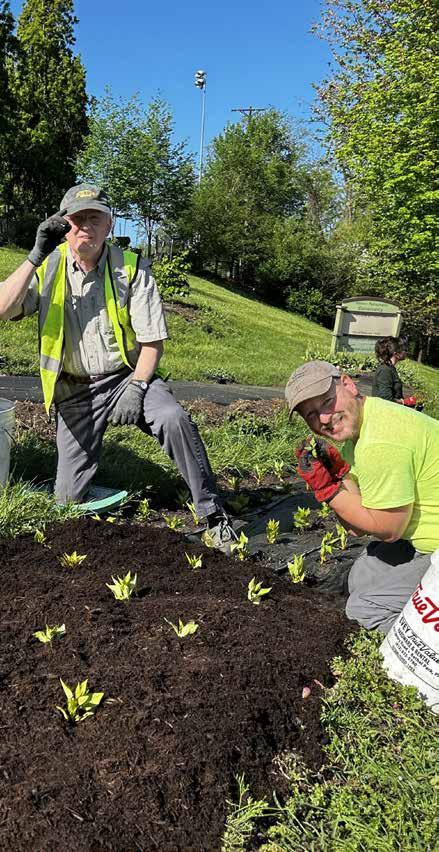
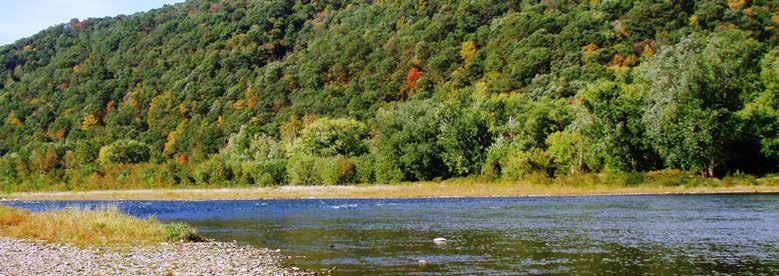
Watershed Conservation
Partnerships Key to Watershed Conservation Efforts
The Conservancy’s watershed conservation staff improved watershed health throughout the region by restoring 43 stream miles in 2024! Working with partners and volunteers, staff employs a variety of strategic approaches and methods including abandoned mine drainage remediation, aquatic organism passage improvements, large woody material restoration, riparian plantings and streambank stabilization.
Work in 2024 related to the Clarion River Protection Project at Clear Creek State Park in Jefferson County included streambank restoration and live stake plantings. The work protected the nationally designated Wild and Scenic Clarion River by restoring a severely eroding shoreline with living vegetation to reduce erosion and sedimentation and beautify the site.

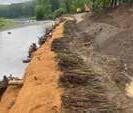

This project improves water quality and aquatic habitat, preserves recreational camp sites at the park and restores the Clarion River’s aesthetic character. Conservancy staff, working with contractors and park staff, stabilized approximately 1,200 feet of streambank along the Clarion River, constructing log and root-wad structures along the base of the riverbank and planting more than 11,520 live native tree stems, including American sycamore, silky dogwood, pussy willow and ninebark on soil terraces. In October and November, staff and volunteers planted live stakes.
Developed over the past seven years, the project highlights the importance of partnerships by enlisting cooperation from several state agencies, Jefferson County Conservation District and Trout Unlimited.
An educational brochure about this project and associated conservation efforts at the park, such as a dam removal and habitat improvements on Clear Creek and freshwater mussel reintroductions in the Clarion River, is being planned, along with a sign that highlights projects and partners involved.
Watershed Program
Honored by PA Wilds
Our watershed conservation program received a 2024 Champions of the PA Wilds Conservation Stewardship Award from the PA Wilds Center. In northcentral Pennsylvania, WPC has assessed more than 1,500 road-stream intersections, helped restore aquatic organism passage at 15 locations, completed abandoned mine land and drainage projects, received a $1.9 million grant to construct a major AMD treatment system on West Creek and facilitated the improvement or construction of 28 public canoe access sites.
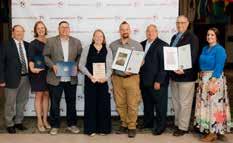
$29,650 distributed through 14 BHGT&S Watershed Mini Grants to grassroots organizations
At Clear Creek State Park on the Clarion River in Jefferson County, wood forms are covered in brush fabric to stabilize soil terraces, then live plant stakes are laid across the terraces. The result is a stabilized, natural streambank.
Groundbreaking Effort Returns Mussels to Rivers
Approximately 4,000 native fatmucket, wavyrayed lampmussel and plain pocketbook mussels received new homes in the Kiskiminetas and Clarion rivers, where they now consume algae and filter the water. The Conservancy’s watershed conservation and natural heritage program staff, partners from the Pennsylvania Fish and Boat Commission and volunteers from the Governor’s Youth Council for Hunting, Fishing and Conservation, and the Watershed Guild donned waders and wetsuits to hand-place freshwater mussels in the rivers in 2024. Grants from the National Fish and Wildlife Foundation, the Colcom Foundation and the PFBC made the work possible.
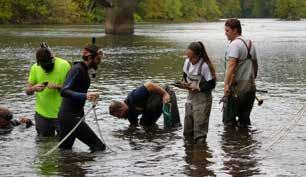
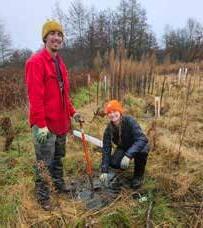

Allegheny River is 2024 River of the Year
For the third time in three decades, the Allegheny River, shown here and on page four, was named Pennsylvania’s River of the Year by the Pennsylvania Department of Conservation and Natural Resources and the Pennsylvania Organization for Watersheds and Rivers in 2024. Since 1965, the Western Pennsylvania Conservancy has protected 116,084 acres of land in the watershed to safeguard habitats and biodiversity for native wildlife, and restored the river and its tributaries to improve water quality for aquatic and terrestrial species.
Fish Move Freely Thanks to Barrier Removals
More fish can swim up- or downstream to feed and breed thanks to our work to reconnect more than nine miles of stream in 2024 by removing 12 barriers to aquatic organism passage. For example, staff surveyed culverts on several state game lands, including SGL #334, 042 and 271, and found numerous culverts to be barriers to aquatic organism passage. “They prohibited the upstream movement of fish,” explains Greg Schaetzle, WPC watershed scientist. “Culverts were replaced with bottomless timber deck bridges. Full aquatic organism passage is now realized.”
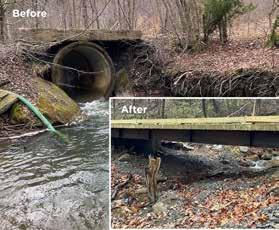
Riparian Plantings Surpass 100,000 Trees
Staff and volunteers planted nearly 46 acres of native riparian trees along streambanks in 15 counties in 2024. Some species include swamp oak, shagbark hickory, willow and dogwood. Riparian trees help to stabilize streambanks, reduce erosion and sedimentation, cool streams to create healthier habitat for fish and other aquatic organisms, and provide food and habitat for wildlife. Since 2013, the Conservancy has planted more than 100,000 riparian trees!
LANDOWNERS WITH STREAMSIDE ACREAGE:
Apply through June 2027 to get free native riparian trees planted. Contact Monica Lee at mlee@paconserve.org or visit
WaterLandLife.org/riparian-restoration-treeplanting-initiative.
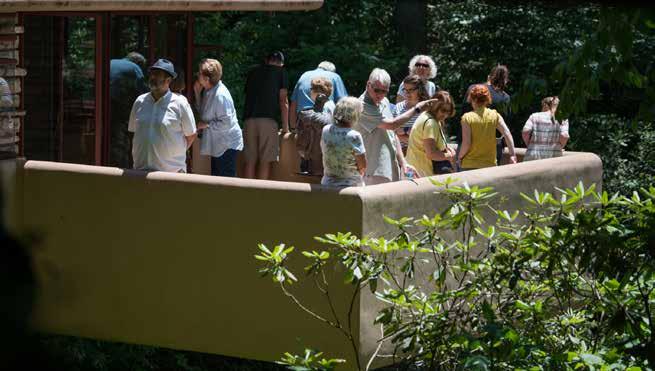
Fallingwater
In July 2024, Fallingwater and seven other Wright-designed sites celebrated a milestone: the five-year inscription to the United Nations Educational, Scientific and Cultural Organization (UNESCO) World Heritage List.
The designation, collectively known as “The 20th-Century Architecture of Frank Lloyd Wright,” highlights and spans 54 years of Wright’s career from 1905 to 1959, representing the first modern architecture serial designation in the U.S. The sites were recognized for their outstanding universal value and their influence on the development of modern architecture internationally.
Fallingwater’s 2024 Fawcett Digital Multimedia Intern, Brandon Karafilis, interviewed several visitors in July for a YouTube video series, asking them what Fallingwater’s inscription meant to them. One visitor, Judy Rubin from Philadelphia, first visited Fallingwater in 1966 and appreciated seeing its unconventional design again. “I loved that Wright said, ‘You build of the hill and not on the hill,’ and with the gorgeous environment and landscape, Fallingwater provides a wonderful experience,” she adds. She was one of 143,023 Fallingwater visitors from 119 different countries in 2024.

New Book Highlights the Kaufmann Collection
Fallingwater Director Justin Gunther and Scott Perkins, senior director of preservation and collections at Fallingwater, put the final edits on their new book, “Fallingwater: Living With And In Art,” which explores the fascinating stories behind the art and furnishings collected by the Kaufmann family. Featuring stunning photography by Dave Bryce and insightful research in essays by leading scholars, the book sheds new light on one of Wright’s most iconic houses and offers a deeper understanding of the Kaufmanns as modern tastemakers and collectors of fine and decorative art from around the world.
“Fallingwater: Living With And In Art” is now available for purchase in stores and online at the Fallingwater Museum Store.
The UNESCO recognition remains a tremendous honor and a lasting testament to the significance of Fallingwater and Wright’s legacy, says Justin Gunther, director of Fallingwater.
“Wright’s work is as relevant as ever, as we are still learning a great deal about how to plan, build and live sustainably with nature,” he adds.
Preservation of Fallingwater remained a priority in 2024. The preservation team at Fallingwater was hard at work advancing the World Heritage Preserved project, the most comprehensive preservation effort in the last 20 years.
1,085
K-12 students engaged in virtual field trips
Preservation Work on Fallingwater’s Roofs and Terraces Advances
Since 2023, Fallingwater’s preservation team, made up of specialized contractors and Fallingwater’s maintenance staff, has been advancing extensive preservation work on the house’s major building systems, including stone masonry, flat roofs, flagstone terraces, steel window and door frames, and concrete walls. Most of the preservation work in 2024 occurred at the Guest House and involved extensive waterproofing repairs, including replacing roofing membranes and injecting grout into the voids of the stone walls. Areas of deteriorated concrete in the parapet wall of the Guest House were also addressed.
Work shifted to the Main House in fall 2024, when extensive scaffolding was erected to carry out masonry repairs on the cantilevered terraces and stone chimney tower. Temporary heated enclosures of insulation board and plastic sheeting allowed the work to be completed during the cold winter months while the house was closed to visitors. Scaffolding surrounding the house was removed in early spring 2025, and work will continue in limited areas during 2025. Fallingwater is currently open for regular-season tours. Stay up to date with this important preservation work via our blog, Fallingwater.org/projects/world-heritage-preservation.

Fallingwater Artists and Scholars-inResidence Explore Creativity
Fallingwater was pleased to welcome several Fallingwater Institute Artists/Scholars-inResidence onsite in 2024. In total, eight new and returning artists and scholars, a few of whom are listed below, found inspiration and discovery at Fallingwater to advance their creative and imaginative processes while immersing themselves in and around the site.
Rhael LionHeart Cape, shown above and better known as LionHeart, is a Londonbased poet whose poetry draws on personal experiences and observations of architectural spaces.
Emma Baiada is a New York-based artist and documentary filmmaker returned to Fallingwater to continue capturing footage of the staff at work.
Kate Joyce, a visual artist from Santa Fe, N.M., created a photographic work focusing on the unique perspectives once enjoyed by Liliane Kaufmann in her bedroom, bathroom and terrace at Fallingwater. Kate also spent the April 2024 solar eclipse at Fallingwater to capture how the sun’s darkening cast shadows on the house and grounds.
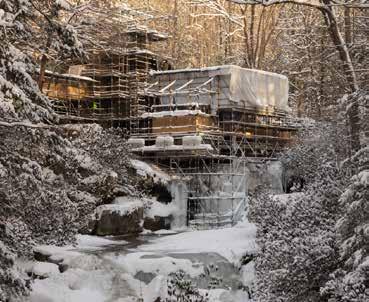
Fallingwater
Institute
Engages
A Variety of Learners From high school residencies to plein air painting workshops, the Fallingwater Institute continues to grow in popularity and relevance. The more than 290 Fallingwater Institute participants in 2024 gained a deeper knowledge and understanding of Fallingwater and Wright’s ideas on organic architecture through hands-on exercises and immersive experiences. For example, a high school residency focused on biophilic design, a practice that emphasizes incorporating nature, engaging the senses and immersing in an environment to improve well-being and enhance the connection between humans, nature and the built environment. Additionally, shown below, institute participants engaged in detailed demonstrations on ikebana techniques and composition led by Sogetsu Pittsburgh.
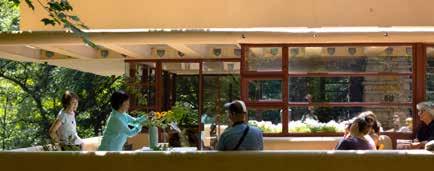
Conservation Science
What do red-belted bumblebees, eastern massasauga rattlesnakes, wood thrushes, least weasels and salamander mussels have in common?
They all are being considered for listing in Pennsylvania’s 2025-2035 Wildlife Action Plan. For inclusion, a species must be ranked as a Species of Greatest Conservation Need in the state.
In 2024, the Conservancy’s Pennsylvania Natural Heritage Program scientists began wrapping up years of studying nearly 2,000 species, including more than 1,400 invertebrate species, for possible inclusion in the state’s Wildlife Action Plan for the first time.
Every 10 years, the Pennsylvania Game Commission and Pennsylvania Fish and Boat Commission update the State Wildlife Action Plan. They rely on WPC’s PNHP staff and other partners to study rare species—a time-intensive and laborious process—and compile existing datasets from experts. They then analyze how rare or threatened a species might be.
The SWAP “is the official conservation document for animals in Pennsylvania,” explains WPC’s PNHP Invertebrate Zoology Coordinator Mary Walsh. “It’s our blueprint for prioritizing conservation planning and management for the animals in it.” The updated plan will be available later in 2025.
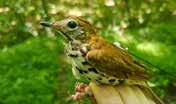
A forest interior breeding bird and Neotropical migrant, wood thrush has seen a total population decline of about 60% since 1970, making it a PA Species of Greatest Conservation Need.
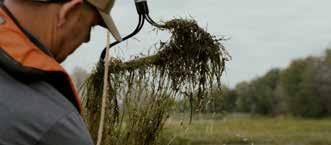
Conservancy Produces Award-winning Film on Aquatic Invasive Species
In 2024, the Conservancy’s Pennsylvania Natural Heritage Program staff executive produced a film, “Seeing The Unseen: Aquatic Invaders & What’s at Stake,” with a generous grant from the Great Lakes Restoration Initiative. The award-winning film, produced by Emmy Award-winning production company Great Lakes Media & Film, explains the negative effects of hundreds of aquatic invasive species on Lake Erie, its watershed and nearby regions, discusses our work to mitigate those effects and provides actions everyone can take to prevent the invasives’ spread.
4,632
common mussels stocked at monitoring sites in the Clarion and Kiskiminetas rivers
Mammals are another area of focus.The Conservancy’s scientists are studying less understood mammals, such the boreal rock vole (Microtus chrotorrhinus) and the Alleghanian spotted skunk (Spilogale putorius), to inform better ecosystem management. The data informs species and habitat conservation through partnerships coordinated by the Pennsylvania Game Commission.
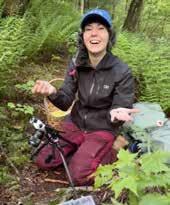
First Conservation Mycologist Focuses on Finding Fungi
Hannah Huber is the first conservation mycologist for the Pennsylvania Natural Heritage Program, a partnership between the Conservancy, Pennsylvania Department of Conservation and Natural Resources, Pennsylvania Game Commission and Pennsylvania Fish and Boat Commission. Hannah assesses the conservation status and stewardship needs of at-risk fungi. Noting that data location for most fungi is limited or nonexistent, Hannah wonders whether those species are rare or simply underdocumented. Therefore, her main focus is on supporting increased, high-quality fungal inventorying and supporting interested people's engagement. In that vein, she plans and networks with PNHP colleagues and with mycology clubs in Pennsylvania.
Conservation Science Staff Makes Discoveries

Rare in Pennsylvania, the Northern yellow lady slipper orchid (Cypripedium parviflorum var. makasin) is at its southern range limit in the Great Lakes region. PNHP ecologists found a new high-quality occurrence during iMapInvasives surveys.
Orchid photo credit: Eleanor Ray, iNaturalist

While driving between study sites, a PNHP invertebrate zoologist stopped to investigate a large patch of Carolina vetch (Vicia caroliniana) growing along a roadside embankment and found Appalachian silvery blue (Glaucopsyche lygdamus lygdamus) caterpillars on the flowers of their sole food plant.
Land Stewardship
Each year, the Conservancy’s land stewardship staff upholds its commitment to actively care for and enhance 45 Conservancy-owned nature preserves that are open to the public for free. The staff also monitors and assesses approximately 230 privately owned properties across the region that are protected by conservation easements.
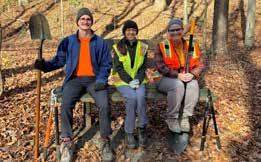
On the Conservancy’s preserves, which total more than 15,300 acres, stewardship activities regularly involve volunteers who help with tasks such as building and maintaining trails, removing exotic invasive plants and installing signs and benches. These improvements make our preserves enjoyable, welcoming areas that support a wide range of recreational activities such as hiking, fishing, hunting and nature watching.
At Toms Run Nature Reserve in Allegheny County, two failing culverts were removed from streams. Because culverts have dramatic impacts on the structure and function of streams, the removals have restored the streams to allow them to function naturally. The trail at Toms Run previously crossed one of the culverts, and hikers can now step across that spot using large stones.
We also undertake activities to help restore land and habitats to support a wide diversity of native plants and animals. For example, at Sideling Hill Creek Conservation Area in Bedford and Fulton counties, the team planted approximately a quarter acre of native wildflowers. Planting wildflowers provides pollen, nectar and nesting sites for butterflies, moths and bees. In addition, the team installed an informational sign at the new parking lot at the preserve, which is open to the public for nature watching, fishing and hunting. This important conservation area protects the unique shale barrens plant community, forests and several globally rare plants. Parking and signage improvements also occurred at Dutch Hill Forest in Jefferson County and at Oakford Park Nature Reserve in Westmoreland County in 2024.
1,544 hours of sweat equity provided by stewardship volunteers
West Branch French Creek
Conservation Area Gets a New Canoe Launch
WPC’s West Branch French Creek Conservation Area contains more than 1,000 acres of contiguous forests, wetlands and stream frontage along the West Branch French Creek, a tributary to French Creek. Open to the public for hiking, birding, wildlife watching, exploring, hunting and fishing, the conservation area is now more accessible to boaters as well. Thanks to funding from our Canoe Access Development Fund, created by Conservancy donors and outdoor enthusiasts Roy Weil and Mary Shaw and managed by our watershed conservation team, a new canoe launch was installed in 2024 along with a new parking area and informational sign.
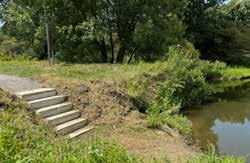
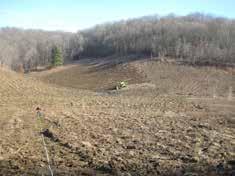
Mine Land
Reforestation Project Launched in Pennsylvania
In the fall of 2024, site preparation began on 100 acres of our 582-acre Lake Pleasant Conservation Area in Erie County for a first-of-its-kind reforestation project in Pennsylvania to restore previously mined land.
The more than 70,000 trees that were planted in spring 2025 will dramatically improve the property’s ecological function, including improving habitat for wildlife and, eventually, increasing the land’s and forest’s capacity to sequester carbon from the atmosphere. The project is part of Bosland Growth’s Legacy Mine and Restoration Initiative, which is funded through grants from federal, state and private partners. Also at Lake Pleasant, staff removed a former field station in preparation for a new pavilion and storage building. The preserve protects most of the 64acre glacial lake’s shoreline, as well as wetlands, upland forests, old fields and reclaimed gravel mines.
Volunteers take a well-deserved rest after making trail improvements at Toms Run Nature Reserve in Allegheny County.
Community Greening

In 2024 the Conservancy celebrated the milestone of 40,000 trees planted through our community forestry programs! Those programs include TreeVitalize Pittsburgh, the Pittsburgh Redbud Project and other regional projects throughout Western Pennsylvania.
Planted along streets and trails and in business districts and parks in 82 City of Pittsburgh neighborhoods and 59 municipalities across Allegheny County and in towns including Ligonier, Erie, New Kensington, Jeannette, Monessen and Johnstown, the 40,000 trees increase tree canopy and tree diversity. Their benefits include cleaning air, storing carbon, providing habitat and food for native wildlife, reducing flood risk by slowing stormwater runoff, and beautifying and cooling communities and streets.
Since 2008, the Conservancy has undertaken community forestry work with partners in many communities throughout Southwestern Pennsylvania, including many in communities facing economic challenges and those with low tree canopy.
The year 2024 saw another milestone, although bittersweet. Cynthia Carrow, WPC’s vice president of government and community relations, retired after nearly 52 years. She held various roles with the Conservancy since 1973!
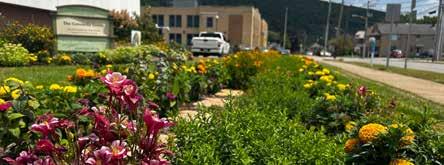
1,094 trees planted in 53 communities
Five decades of conservation creates plenty of memories. Cynthia says an excellent example of transformation that she witnessed is WPC’s work in the Clarion River watershed. “I remember so vividly in the late 1970s, canoeing on the black polluted water of the Clarion River,” she recalls. “The Conservancy mapped out a conservation strategy for a 40-mile stretch from Elk County to Clarion County.”
With nearly 33,000 acres conserved (and counting), the Conservancy and partners have worked to restore water quality. “Today most of this section of the Clarion River is designated Wild and Scenic by the National Wild and Scenic Rivers System,” Cynthia says. “I plan to canoe the Clarion and will now have plenty of free time to enjoy the places we’ve worked to protect and restore!”
Cynthia leaves a legacy of insightfulness, kindness, hard work and a true passion for conservation. We congratulate and thank her for her lifetime of service protecting and conserving water, land and wildlife for this and future generations.
Upon Cynthia’s retirement, we welcome two new members to WPC’s leadership team: Associate Vice President of Urban Forestry and Community Greening Jeff Bergman, formerly WPC’s senior director of community forestry, and Associate Vice President for Government and Community Relations Mike Kuzemchak, formerly senior director of operations at Fallingwater.
More Gardens Feature Native Perennial Beds
Volunteers helped plant native perennial beds in 12 WPC community flower gardens in 2024, including in Wilkinsburg, Shippenville, Connellsville and the one pictured here in Franklin. The plants provide food and habitat to support pollinators and help manage stormwater runoff. Funded by generous grants from TC Energy, KeyBank and Pennsylvania Department of Conservation and Natural Resources, the beds feature native plants such as bee balm, milkweed and black-eyed Susan.
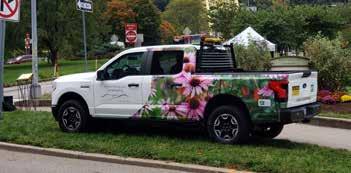
Electric Trucks Drive Sustainability Efforts
Thanks to a $150,000 grant from Green Mountain Energy Sun Club, the Conservancy purchased two 2023 Ford F-150 Lightning electric trucks to transport plants, mulch and tools to our 130 community flower gardens and to community treeplanting sites. Ford Motor Company donated two charging stations to charge the extended-range electric batteries, which get up to 320 miles per charge. The trucks will save an estimated $20,000 in fuel costs and $10,000 in maintenance costs over the next 10 years!
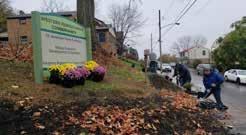
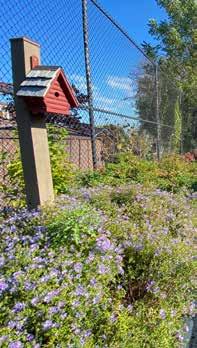
Thank you, PNC Foundation, for 12 years of PNC Grow Up Great Funding!
Since 2012, PNC Grow Up Great has partnered with the Conservancy, providing $725,000 in support to add natural outdoor play and learning spaces at 12 Pittsburgh Public Schools’ early childhood centers. In 2024, PNC Foundation pledged ongoing financial support to the Conservancy for more PNC Grow Up Great initiatives to commemorate the program’s 20th anniversary.
As part of our school grounds greening program, the spaces provide safe places for children to interact with nature, encouraging motor skill development, nurturing creativity and stimulating curiosity. Working closely with Pittsburgh Public Schools’ faculty and staff, Conservancy staff has incorporated playful, educational elements such as mosaic birds and flowers, climbing rocks, farmers market stands, stationary musical instruments, birdhouses, and tree and sensory perennial plantings.
Native Plants Fill Vacant Lot in Mt. Oliver
In Pittsburgh’s Mt. Oliver neighborhood, community members and Pennsylvania American Water employees helped to transform a vacant lot at the intersection of Stamm Avenue and Walnut Street into a beautiful, functional outdoor community space that includes native perennial beds featuring coreopsis, yarrow and aster. Sponsored by Pennsylvania American Water, the garden was installed in partnership with Hilltop Economic Development Corporation and the Borough of Mount Oliver.
Rain Gardens Help Manage Stormwater in Kittanning
Thanks to a grant from American Water Charitable Foundation, walkers, bicyclists and other outdoor enthusiasts now enjoy two native perennial gardens along the Armstrong Trail in Kittanning, Armstrong County. The gardens’ 367 native plants, including beardstongue, iris and rudbeckia, help to mitigate erosion and excessive ponding along the trail, and provide food and habitat for pollinators. The gardens were installed in partnership with the Armstrong County Board of Commissioners, Kittanning Borough, the Downtown Kittanning Revitalization Committee and Armstrong Trails.
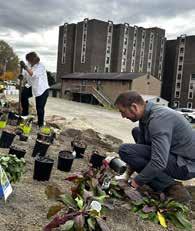
VOLUNTEER to steward a community garden throughout the year, or to plant gardens or trees during spring or fall. Visit WaterLandLife.org/events for opportunities.
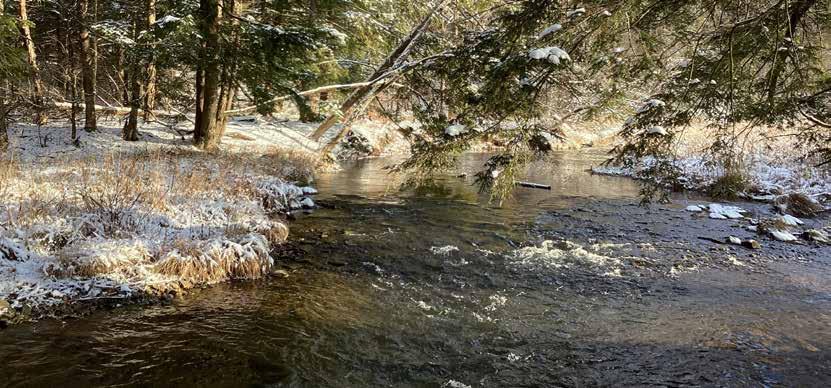
Land Conservation
Land protection is essential for many reasons, including conserving habitat for native plants and animals, preserving large forests, safeguarding biodiversity, mitigating climate change and ensuring that natural land remains for future generations. Since the 1950s, the Conservancy has safeguarded Western Pennsylvania’s land, forests, waters and other valuable natural resources and special habitats. In 2024, Conservancy staff protected 10 properties totaling 22,965 acres, bringing the total land protected to more than 290,000 acres.
Access to forests and natural areas is vital to the lifestyle and economic wellbeing of many Pennsylvania residents. In 2024, the Conservancy’s land protection efforts continued to uphold those traditions, such as hunting and fishing, by adding more than 2,000 acres to state public game lands, forests and parks.
We also worked closely with The Conservation Fund to permanently conserve almost 20,000 acres in the Pennsylvania Wilds in McKean and Elk counties through a donation of a conservation easement, a land protection option available to landowners who wish to retain ownership of their property while preserving the land’s conservation values in perpetuity.
The project, shown above and known as the Clarion Junction conservation easement, protects sweeping ridges, scenic hardwood forests, segments of the
22,965 total acres protected in 2024
Clarion River and many high-quality tributaries that support wild trout. The hardwood forests consist of red and sugar maple, black cherry, yellow and black birch, red oak and Eastern hemlock. The property forms an important connection between state forest, state game land and the Allegheny National Forest. Although the land is privately owned, the easement enables public recreational access for hunting, hiking, fishing and wildlife watching.
The easement limits future development while allowing for the continuation of sustainable forestry operations on the property. This forest provides a steady source of wood for the local forest products industry, which includes a paper mill in downtown Johnsonburg. The Conservancy’s stewardship staff will be responsible for monitoring the property to ensure it remains in compliance with the easement provisions. This property is important not just because it protects large acreage, but also because it provides connectivity to other nearby protected public lands, says Conservancy President and CEO Thomas Saunders.
“We appreciate The Conservation Fund’s donation of this important conservation easement that permanently protects this open space, large working forest, beautiful natural area and important habitat,” says Saunders. “We are glad to steward these streamside forestlands to ensure they remain thriving ecosystems for generations to come.”
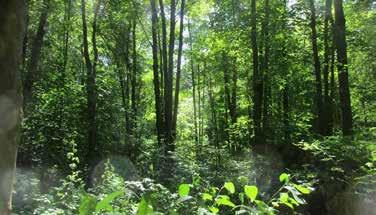
Tryon-Weber Woods Natural Area in Crawford County Expands
The Conservancy added 23 forested acres in Sadsbury Township, Crawford County, to its Tryon-Weber Woods Natural Area in 2024. The property hosts vernal pools, which are seasonal wetlands providing habitat for plants and animals. Located in the Shenango River watershed, the now 131-acre preserve is open to the public for hiking, wildlife watching, exploring and hunting. First protected by the Conservancy in 1976, this natural area consists primarily of upland forest and a small stream valley with hillsides flecked with trillium, violets, bellwort and wild geranium in the spring. Some trees in the preserve are more than 120 years old and recognized as exemplary by the Old-Growth Forest Network.
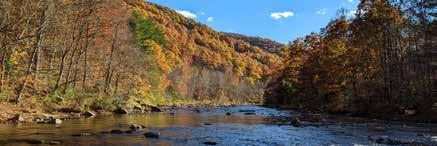
More Land Saved in Pennsylvania’s Vast Elk Range
Nearly 1,500 acres of steep forested slopes and a significant riparian area along the Bennett Branch Sinnemahoning Creek are now protected in Benezette Township, Elk County. The property was immediately transferred to the Pennsylvania Department of Conservation and Natural Resources to become open to the public as an addition to Moshannon State Forest. The Conservancy has been protecting and restoring land in the Bennett Branch corridor since 2008, with more than 8,300 acres protected in Bennetts Valley.
New Nature Preserve Opens in Venango County
The Conservancy protected 250 forested acres along Deer Creek Road in Frenchcreek Township, Venango County, and created a new nature preserve, now known as French Creek Hemlocks Natural Area. A mix of forest and wetlands, the preserve hosts more than one mile of frontage on French Creek, along with mature American beech, red maple, white pine and Eastern hemlock trees. This natural area is open to the public for outdoor recreation, including hiking, birding, hunting and wildlife watching, as well as nature study and research. Additionally, the new preserve will provide one of the county’s few public fishing access points along French Creek.
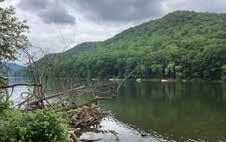
Property Near the Allegheny Islands Wilderness Now Protected
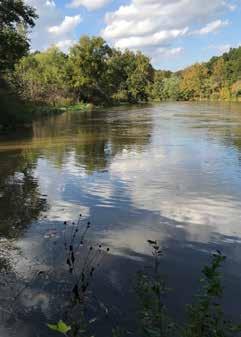
Forested land along the Allegheny River is now permanently protected thanks to a conservation easement donation from Randall Gustafson on 28 acres of his property in Pleasant and Watson townships, Warren County. “It was important to my family that our property remain natural forever,” says Mr. Gustafson as he reflected on how his father, who was a lumberman and community leader, also taught him how to fish on the banks of the Allegheny. “My wife and I taught our kids how to fish here, too, so it’s reassuring that the legacy of this special place will continue to endure long after I’m gone.”
2O24 Financial Summary


With Gratitude to Our Generous Donors
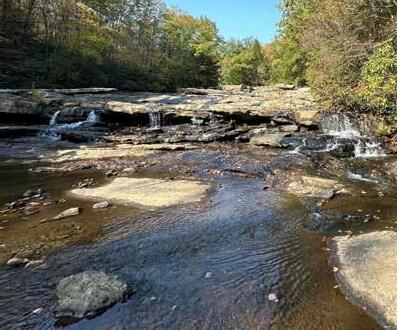
The Western Pennsylvania Conservancy received support from 10,886 private donors (individuals, corporations, foundations and organizations) that together made cash, stock and in-kind gifts totaling $14,602,914 in 2024. Their extraordinary generosity played a significant role in advancing WPC’s mission of protecting water, land and wildlife in Western Pennsylvania as well as the iconic Frank Lloyd Wright-designed Fallingwater.
We are also delighted to recognize both the generous future commitments of our Heritage Circle members as well as remember the legacies of those who have passed on in 2024. Together, they provide transformational support for the Conservancy to care for our beautiful region now and in the future.
Donors making gifts totaling $250 or more, and Evergreen Circle members who gave $100 or more are listed on the following pages. We regret that space constraints prohibit acknowledging all supporters by name. We have made every effort to ensure that our donor lists are accurate and reflect gifts made last year; however, should you find an error or omission, please contact Nicole Walsh, donor stewardship manager, toll-free at 1-866-564-6972 (ext. 2322) or via email at nwalsh@paconserve.org.
How You Can Help
The Western Pennsylvania Conservancy relies on the support of more than 10,600 member households and its volunteers to fulfill its mission. Your continued involvement will ensure that our work continues.
Heritage Circle Gift Planning Society
The Heritage Circle recognizes donors who have made the Western Pennsylvania Conservancy a part of their legacy through their estate plans. By designating the Conservancy as a beneficiary of a will, trust, IRA, retirement plan, life insurance policy or charitable gift annuity, individuals provide long-term, significant support for the Conservancy. Contact Julie Holmes, senior director of development, toll-free at 1-866-564-6972 (ext. 2312) or jholmes@paconserve.org for details.
Annual Fund
Gifts to the annual fund are essential in sustaining our daily operations. These vital contributions enable the Conservancy to carry out its mission throughout the year. You can also provide dependable income for WPC and Fallingwater by making your annual gift through convenient monthly deductions via credit card or debit from a designated financial account. For more details, contact Kathy Patrignani, development operations administrator, at 1-866-564-6972 (ext. 2340) or via email at kpatrignani@paconserve. org. Additional information can be found on our website at WaterLandLife.org.
Leadership Circle and Kaufmann Society
The Conservancy’s Leadership Circle members, including Kaufmann Society donors whose gifts are designated for Fallingwater, have made the Western Pennsylvania Conservancy’s work a philanthropic priority. Members who make annual gifts of $1,000 or more are recognized through the Leadership Circle and Kaufmann Society.
The Conservancy recognizes this significant commitment by providing enhanced access to our programs, special outings and additional insights into our plans throughout the year. Become a monthly donor and make your $1,000+ annual gift in convenient monthly deductions—a simple way to make a big difference! Please contact Julie at 1-866-564-6972 (ext. 2312) or via email at jholmes@paconserve.org for information.
Evergreen Circle
Members of the Evergreen Circle have loyally supported the Conservancy for at least 15 out of the last 20 years. Some have been members for much longer—with memberships dating back to the 1950s! Their loyal and continuous support has been a crucial part of our successful work. We are deeply grateful for those who constantly support our efforts each and every year.
Employee Matching Gift Program
Many companies and organizations will match employee contributions, greatly increasing the impact of your gift to the Conservancy. Please contact your human resources office for further information.
Special Gifts
The Conservancy deeply appreciates gifts of appreciated stock, real estate property, in-kind gifts and multiyear commitments in support of our programs. Please contact the Conservancy’s development office at 1-866-564-6972 or development@paconserve.org for more information.
800 Waterfront Drive Pittsburgh, PA 15222
412-288-2777
info@paconserve.org
WaterLandLife.org
Fallingwater.org
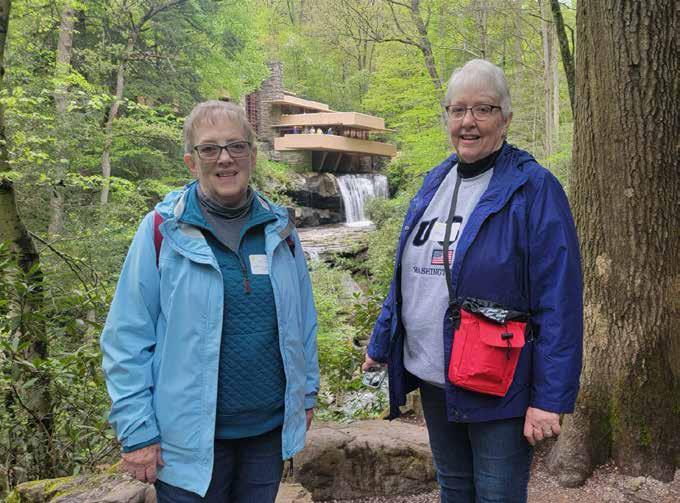
Leave a Legacy
By including the Western Pennsylvania Conservancy in your estate plans, you can make a lasting difference throughout the region.
Your legacy will help ensure the long-term protection of the region’s most remarkable places, including Fallingwater, Frank Lloyd Wright’s iconic masterpiece. There are many ways to leave a legacy, but one of the simplest and most common is through a bequest in your will or trust.
To learn more about planned giving options—or to let us know if you’ve already included the Conservancy or one of its programs, such as Fallingwater, in your estate planse— please contact Julie Holmes, senior director of development, at 412-586-2312 or jholmes@paconserve.org.
DISCOVER the many ways you can create a legacy at the Western Pennsylvania Conservancy with a gift from your estate.
